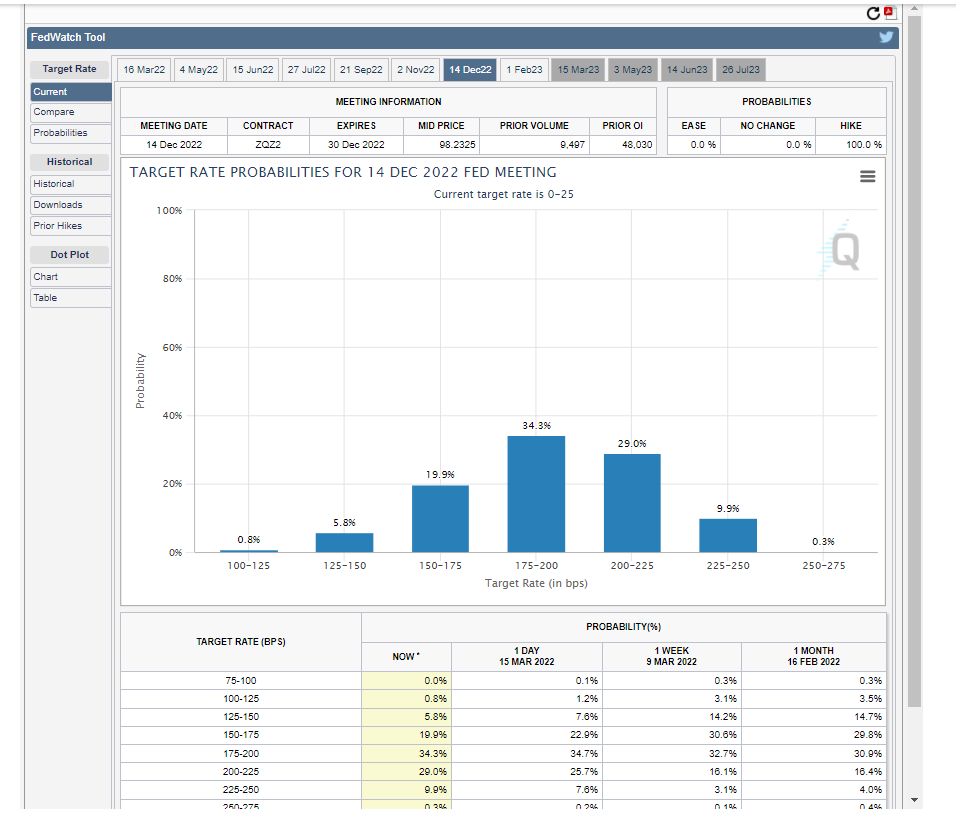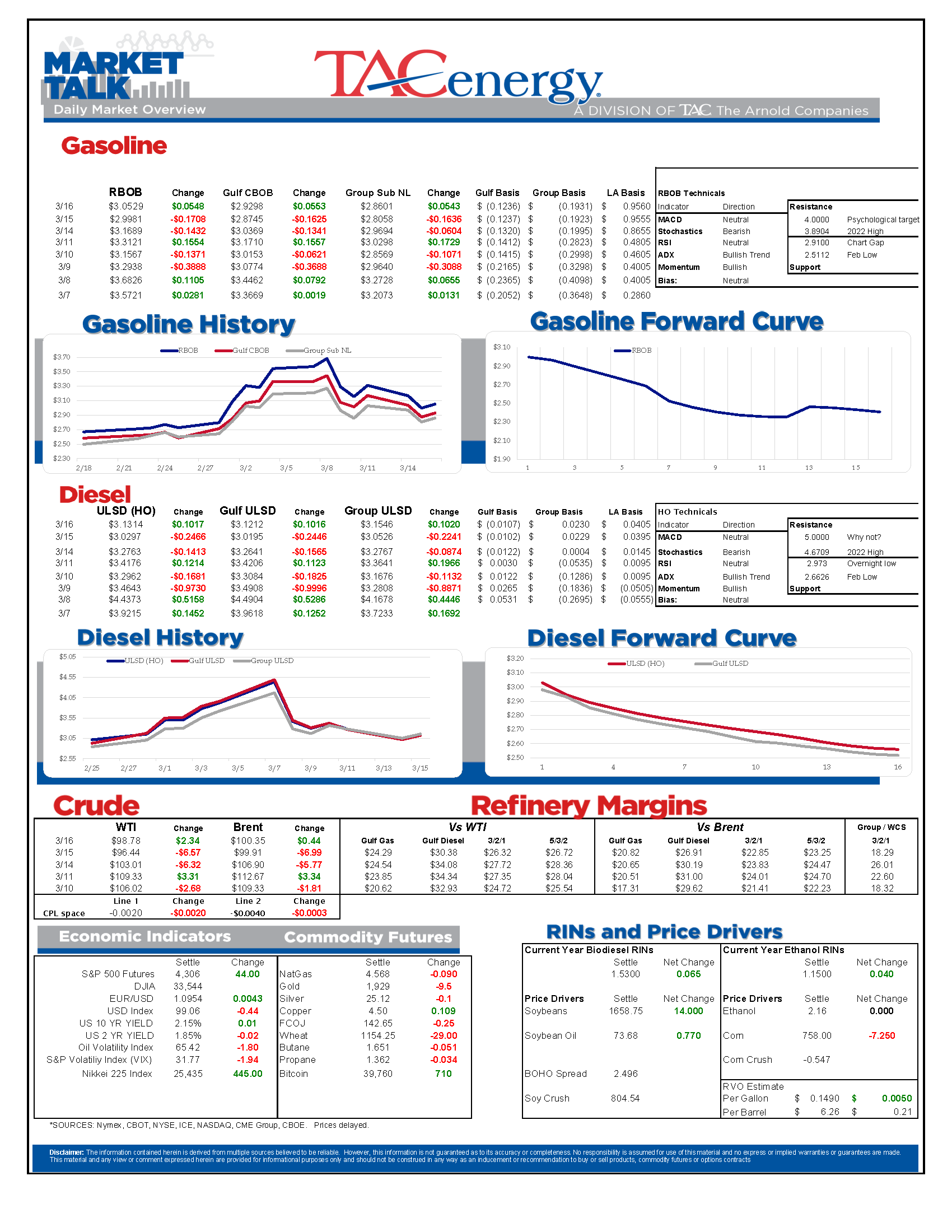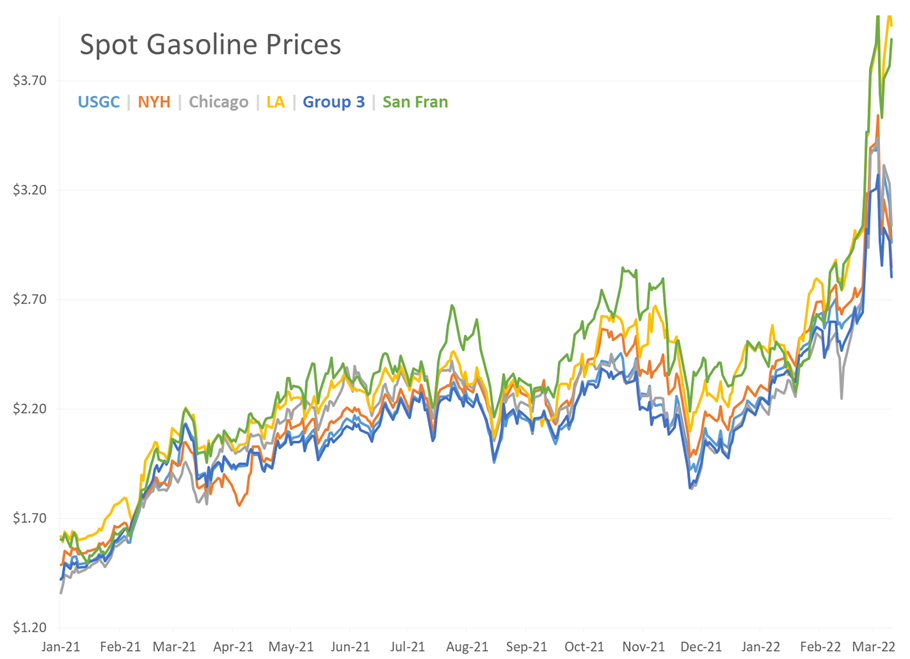Energy Prices Are Bouncing After 2 days Of Heavy Selling To Start The Week

Energy prices are bouncing after 2 days of heavy selling to start the week. While the moves so far are mild compared to what we’ve been used to so far in March, technical and fundamental factors are hinting that there may be more room to move higher in the weeks to come.
RBOB futures closed the chart gap left behind by the roll to the summer spec contract at the end of February during Tuesday’s melt-down, but held above its bullish trend-line on the weekly report, both of which are bullish factors leaving room on the charts for more upside just in time for the seasonal jump in demand. ULSD also managed to hang onto the upward sloping trend line despite dropping 30 cents on Tuesday, and was rewarded with a 10 cent bounce so far today.
The IEA is reducing its global oil demand estimate by 1.3 million barrels/day for the rest of the year, and its refinery throughput by 1.1 million barrels/day both due to the war in Ukraine, which it says, “…could turn into the biggest supply crisis in decades.” The report also notes that only Saudi Arabia and the UAE have the capacity to bring more oil to the global market quickly, and the other options will take several months at a minimum, IF agreements can be made.
OPEC left its global demand estimate “under assessment” in its March oil output, acknowledging that the fallout from the war in Ukraine will lead to a decline in consumption, but not willing to make an official guess by how much given the chaotic and rapid nature of the changes taking place in the global economy.
Speaking of which, the chaotic trading of the past couple of weeks is also creating concerns of a repeat of the 2008 liquidity crisis, with billions of dollars in margin calls putting some companies on the brink of insolvency. Since 2008, banks have been finding new ways to circumvent the laws put in place to keep them acting like banks and not the biggest oil traders in the world (which is why the actual traders have to rush their EFP orders to the exchange in 15 minutes or less) and now Barclays has announced it was suspending its ETN tied to crude oil after it realized that pushing these contracts on its customers is not a good idea when prices are moving this quickly.
For those that remember the oil price spike that killed Semgroup in 2008, and its “bank’s” alleged role in that short squeeze, it’s not hard to imagine the fallout that could still come from the whipsaw action we just witnessed over the past two weeks.
If you think that’s a little dramatic, just look at what happened in the Nickel market again this morning.
Speaking of dramatic, West Coast gasoline markets are doing their diva impressions once again, with basis values in both northern and southern California soaring to nearly $1/gallon over futures as refinery disruptions and a lack of replacement options thanks to the state’s boutique grades hammer those markets while other regions have enjoyed a bit of relief as prices have pulled back sharply over the past week.
The API reported a draw in gasoline stocks last week of nearly 3.8 million barrels, while distillates had a small build of less than 1 million barrels. There is plenty of evidence of a spike in demand over the past couple of weeks as consumers panicked over rising prices and potential supply shortages, which could manifest as large inventory draws in today’s DOE report.
The FOMC announcement is expected at 1pm central. According to the CME’s fedwatch tool, just about everyone expects a 25 point rate increase today (the first increase in 3 years) and just about everyone is planning that this will be the first of at least 6 rate hikes for the year.
Click here to download a PDF of today's TACenergy Market Talk.
Latest Posts
Gasoline Futures Are Leading The Way Lower This Morning
The Sell-Off Continues In Energy Markets, RBOB Gasoline Futures Are Now Down Nearly 13 Cents In The Past Two Days
Week 15 - US DOE Inventory Recap
Prices To Lease Space On Colonial’s Main Gasoline Line Continue To Rally This Week
Social Media
News & Views
View All
Gasoline Futures Are Leading The Way Lower This Morning
It was a volatile night for markets around the world as Israel reportedly launched a direct strike against Iran. Many global markets, from equities to currencies to commodities saw big swings as traders initially braced for the worst, then reversed course rapidly once Iran indicated that it was not planning to retaliate. Refined products spiked following the initial reports, with ULSD futures up 11 cents and RBOB up 7 at their highest, only to reverse to losses this morning. Equities saw similar moves in reverse overnight as a flight to safety trade soon gave way to a sigh of relief recovery.
Gasoline futures are leading the way lower this morning, adding to the argument that we may have seen the spring peak in prices a week ago, unless some actual disruption pops up in the coming weeks. The longer term up-trend is still intact and sets a near-term target to the downside roughly 9 cents below current values. ULSD meanwhile is just a nickel away from setting new lows for the year, which would open up a technical trap door for prices to slide another 30 cents as we move towards summer.
A Reuters report this morning suggests that the EPA is ready to announce another temporary waiver of smog-prevention rules that will allow E15 sales this summer as political winds continue to prove stronger than any legitimate environmental agenda. RIN prices had stabilized around 45 cents/RIN for D4 and D6 credits this week and are already trading a penny lower following this report.
Delek’s Big Spring refinery reported maintenance on an FCC unit that would require 3 days of work. That facility, along with several others across TX, have had numerous issues ever since the deep freeze events in 2021 and 2024 did widespread damage. Meanwhile, overnight storms across the Midwest caused at least one terminal to be knocked offline in the St. Louis area, but so far no refinery upsets have been reported.
Meanwhile, in Russia: Refiners are apparently installing anti-drone nets to protect their facilities since apparently their sling shots stopped working.
Click here to download a PDF of today's TACenergy Market Talk.

The Sell-Off Continues In Energy Markets, RBOB Gasoline Futures Are Now Down Nearly 13 Cents In The Past Two Days
The sell-off continues in energy markets. RBOB gasoline futures are now down nearly 13 cents in the past two days, and have fallen 16 cents from a week ago, leading to questions about whether or not we’ve seen the seasonal peak in gasoline prices. ULSD futures are also coming under heavy selling pressure, dropping 15 cents so far this week and are trading at their lowest level since January 3rd.
The drop on the weekly chart certainly takes away the upside momentum for gasoline that still favored a run at the $3 mark just a few days ago, but the longer term up-trend that helped propel a 90-cent increase since mid-December is still intact as long as prices stay above the $2.60 mark for the next week. If diesel prices break below $2.50 there’s a strong possibility that we see another 30 cent price drop in the next couple of weeks.
An unwind of long positions after Iran’s attack on Israel was swatted out of the sky without further escalation (so far anyway) and reports that Russia is resuming refinery runs, both seeming to be contributing factors to the sharp pullback in prices.
Along with the uncertainty about where the next attacks may or may not occur, and if they will have any meaningful impact on supply, come no shortage of rumors about potential SPR releases or how OPEC might respond to the crisis. The only thing that’s certain at this point, is that there’s much more spare capacity for both oil production and refining now than there was 2 years ago, which seems to be helping keep a lid on prices despite so much tension.
In addition, for those that remember the chaos in oil markets 50 years ago sparked by similar events in and around Israel, read this note from the NY Times on why things are different this time around.
The DOE’s weekly status report was largely ignored in the midst of the big sell-off Wednesday, with few noteworthy items in the report.
Diesel demand did see a strong recovery from last week’s throwaway figure that proves the vulnerability of the weekly estimates, particularly the week after a holiday, but that did nothing to slow the sell-off in ULSD futures.
Perhaps the biggest next of the week was that the agency made its seasonal changes to nameplate refining capacity as facilities emerged from their spring maintenance.
PADD 2 saw an increase of 36mb/day, and PADD 3 increased by 72mb/day, both of which set new records for regional capacity. PADD 5 meanwhile continued its slow-motion decline, losing another 30mb/day of capacity as California’s war of attrition against the industry continues. It’s worth noting that given the glacial pace of EIA reporting on the topic, we’re unlikely to see the impact of Rodeo’s conversion in the official numbers until next year.
Speaking of which, if you believe the PADD 5 diesel chart below that suggests the region is running out of the fuel, when in fact there’s an excess in most local markets, you haven’t been paying attention. Gasoline inventories on the West Coast however do appear consistent with reality as less refining output and a lack of resupply options both continue to create headaches for suppliers.




